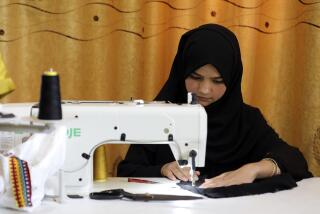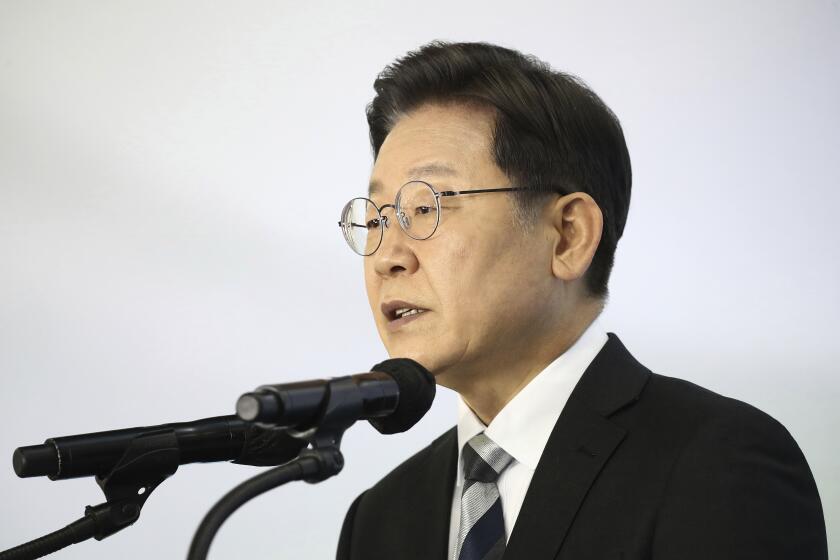Afghan Faction Battles to Eject Foes : Asia: Moderate rebels control most of western Kabul. But hard-line rivals are proving to be stubborn and well-armed holdouts.
- Share via
KABUL, Afghanistan — Warring Muslim guerrilla factions blasted away at ancient forts, a martyrs’ cemetery and apartment buildings Monday in the bloody urban battle to claim the capital, while a convoy carrying a coalition of moderate politicians and religious leaders was stalled in its efforts to fill Kabul’s power vacuum.
Platoons of moujahedeen warriors loyal to moderate Commander Ahmed Shah Masoud secured most of Kabul’s strategic and symbolic military strongholds, consolidating their hold on the city’s downtown and on many terrified residential neighborhoods with machine-gun nests, roadside checkpoints and the green flag of their Jamaat-i-Islami party.
But hundreds of rival guerrillas loyal to extremist leader Gulbuddin Hekmatyar, who seized vast stores of arms and ammunition and several tanks in Saturday’s rebel race to win the capital, stubbornly resisted aerial and artillery bombardments and tank barrages at their strategic position at the southern entrance to the city. One of those units, a large armored force, launched rocket attacks on Kabul’s airport from positions about 10 miles to the south.
Two AN-32 transport planes were sent to pick up the coalition leaders who had left neighboring Pakistan by road Monday morning, but they returned empty, with no explanation given.
Among the 51 members of the compromise government in the convoy was Sibghatullah Mojaddidi, a revered Sunni Muslim cleric selected as president of the moderate coalition. The cleric’s son, Najibullah Mojaddidi, told reporters waiting at the Kabul airport that the group had crossed the border into Afghanistan but that it would not reach Kabul for a day or two.
As he spoke, a nearby residential neighborhood was battered by a barrage of rockets that Hekmatyar’s fighters launched toward the airport, a frequent though rarely hit target of the Muslim guerrillas during the 13-year war with the authoritarian regime.
And the battle of Bala Hissar, a 5th-Century fort that is Masoud’s stronghold on the southern approach road to Kabul, raged on.
Dozens of guerrillas loyal to Masoud’s military coalition of guerrillas, former army officers and tribal militiamen once allied with the regime were wounded and several were killed as they continued to use tanks, rockets, bombs, mortars and machine guns to drive out Hekmatyar’s forces.
Bombs and tank shells rained all day and night on the city’s Cemetery to the Martyrs, where a combined force of Hekmatyar’s Hezb-i-Islami party and ethnic Pushtuns from the regime’s paramilitary Sarandoy unit was holding out. They directed their fire at the Bala Hissar fort, a strategic site known as “the landmark of the capital.”
Dead and bleeding Jamaat guerrillas were carried out of the fort’s 12-foot-thick walls. Hundreds of others fired back toward the Hezb-i-Islami positions inside the cemetery. But nothing appeared to dislodge the forces in the cemetery.
Firefights also raged in the oldest of the weathered and cracking Soviet-built apartment blocks, where Hezb-i-Islami forces that had been flushed out of police stations and paramilitary bases regrouped and forced hundreds of families to evacuate.
Some of Hekmatyar’s loyalists, surrounded and cut off, remained holed up inside the large Interior Ministry complex in the heart of the city.
Masoud’s soldiers were negotiating with those inside, and foreign diplomats said they expected Masoud’s forces to talk them out rather than attack.
The coalition quickly abandoned its initial tactic of merely disarming Hezb-i-Islami guerrillas and chasing them off from their old positions when it became clear that the fighters were merely regrouping, rearming and claiming new strategic real estate.
By day’s end, it was clear that Masoud’s moderate coalition had secured most of the western half of the city.
“I think that 90% of the city is under our control now,” said the younger Mojaddidi, who is a member of the six-man emergency council trying to bring order to the urban war zone. It was the first public comment by any members of the council, which includes Masoud.
Throughout the day Monday, Masoud loyalists moved quickly and purposefully to consolidate and imprint their new, Islamic rule over Kabul, putting up hundreds of the green Jamaat-i-Islami flags on rooftops, mud compound walls and the antennas of the Soviet-built sedans they confiscated from the regime.
Peace committees of Jamaat-i-Islami guerrillas, carrying AK-47 assault rifles and rocket launchers, moved from block to block and house to house, reassuring residents that they were safe and identifying themselves as the new law in town.
The guerrillas acted as detectives, taking down details and interrogating suspects whenever there were complaints of home lootings during the rebel free-for-all for the capital. The guerrillas hugged and shook hands with the few shop owners who dared open their shutters. They directed the little traffic that moved through the streets.
“I think in two or three days, everything will be all right,” said Mohammed Sayed, a laborer who walked several blocks to buy cigarettes in a neighborhood under Jamaat control.
More to Read
Sign up for Essential California
The most important California stories and recommendations in your inbox every morning.
You may occasionally receive promotional content from the Los Angeles Times.













